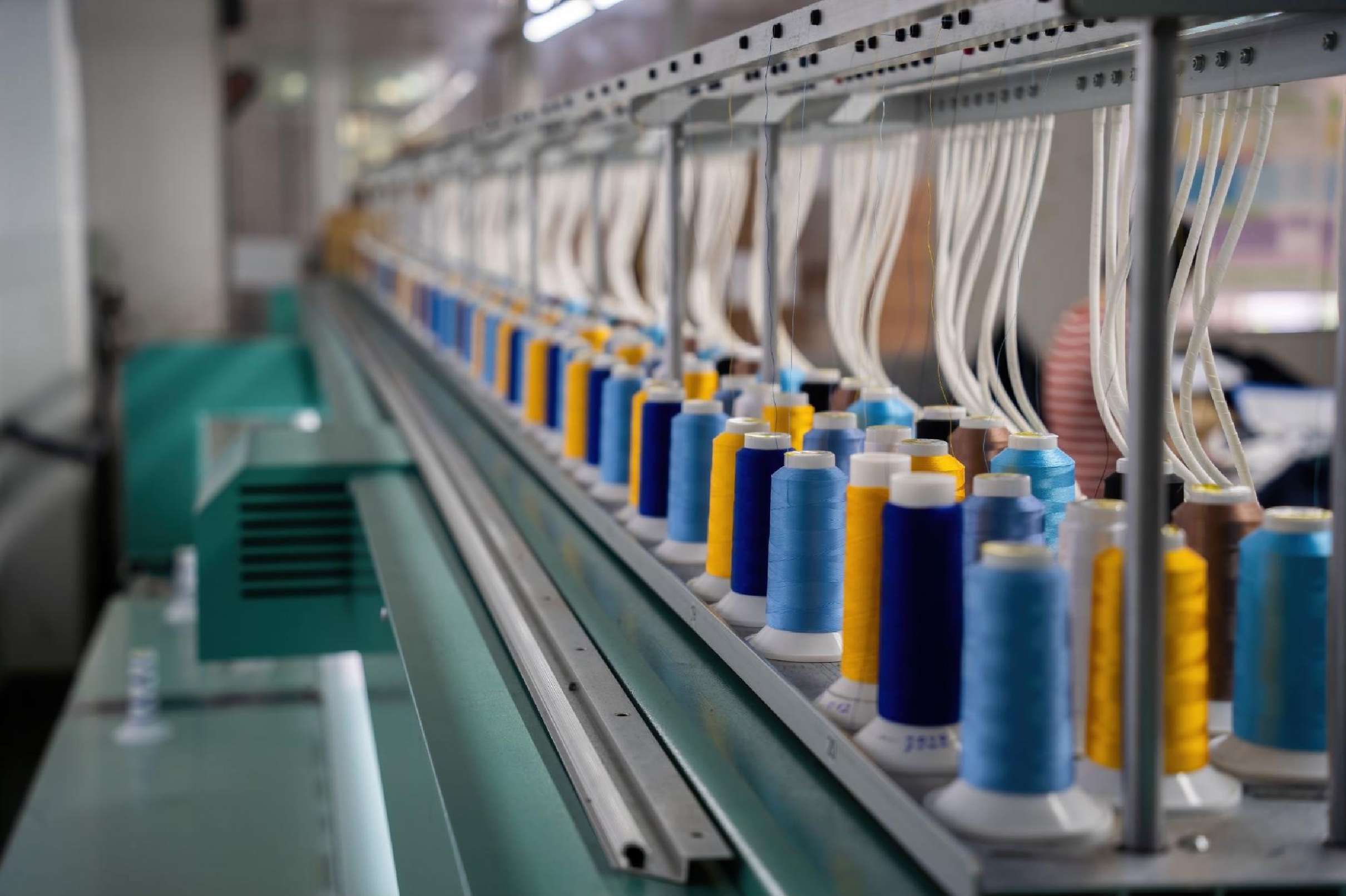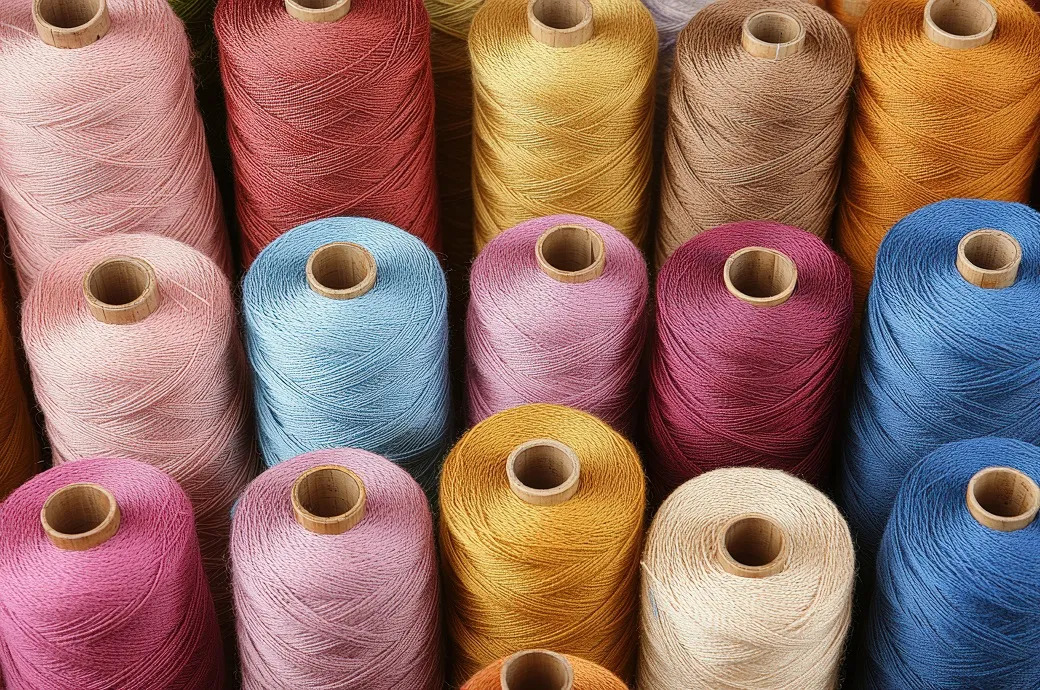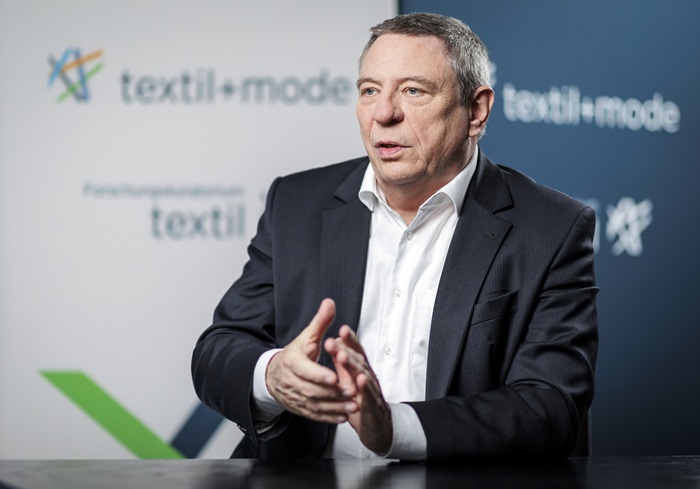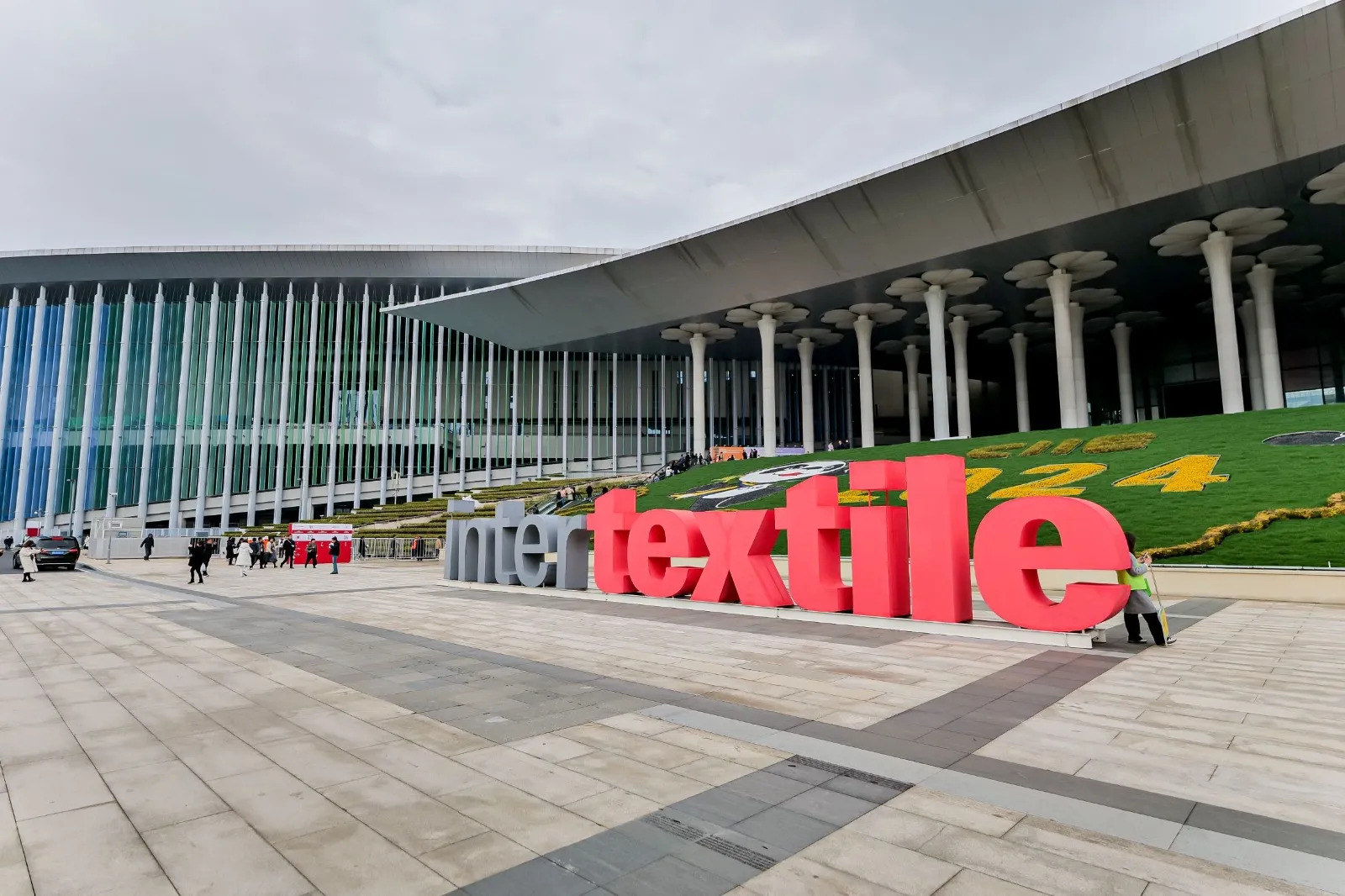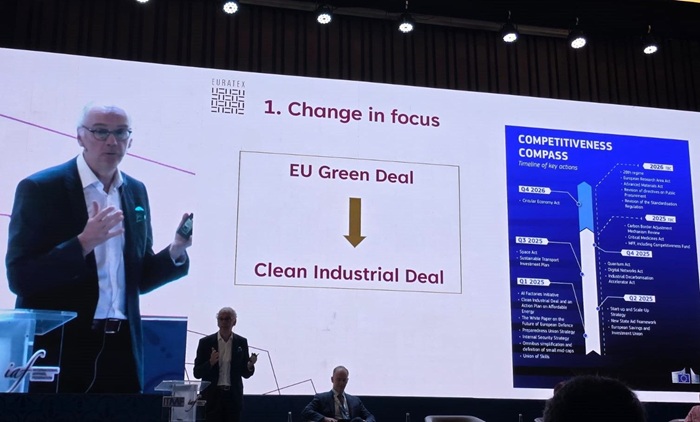FW

Bangladesh is rapidly strengthening its position as a major player in the global apparel export market, capitalizing on a shift in dynamics within the EU and the US, the world's two largest economic blocs. Recent data reveals an increase in Bangladesh's apparel exports to these major markets, largely due to its ability to fill the vacuum left by a retreating China. This upward movement underscores Bangladesh's growing competitiveness, its strategic advantages and evolving global trade patterns.
Europe embraces Bangladesh
The latest Eurostat figures, cited by the Bangladesh Garment Manufacturers and Exporters Association (BGMEA) highlights the country’s growing influence in the European apparel market. In the first two months of 2025 (January-February), Bangladesh witnessed 36.99 per cent increase in apparel exports to the EU, reaching $3.69 billion, a significant leap from the $2.69 billion recorded during the same period last year.
This impressive growth far outpaces the EU's overall apparel import growth of 17.81 per cent in value and 28.66 per cent in volume, unequivocally showcasing Bangladesh's prowess in capturing market share. Industry experts suggest that China's declining market share in the EU has created a significant opening, which Bangladesh has adeptly exploited.
Table: EU apparel imports - Bangladesh vs. competitors (Jan-Feb 2025)
|
Country |
Export value ($ bn) |
Growth rate (%) |
|
Bangladesh |
3.69 |
36.99 |
|
China |
4.54 |
25 |
|
Turkey |
- |
-3.64 |
|
India |
- |
21-22 |
|
Pakistan |
- |
21-22 |
|
Cambodia |
- |
21-22 |
|
EU Overall |
- |
17.81 (Value), 28.66 (Volume) |
The data clearly indicates that while other exporting nations are also experiencing growth, Bangladesh's performance is significantly more robust. Notably, Turkey's exports have even declined, further highlighting Bangladesh's competitive edge. While China remains the largest exporter to the EU, the narrowing growth gap signals a potential long-term shift.
US market, resilience amidst uncertainty
Simultaneously, Bangladesh's apparel exports to the US have also shown resilience, growing at 17.23 per cent during the July-March period of the 2024-25 fiscal year, reaching $5.74 billion. This growth is particularly noteworthy considering the looming concerns surrounding new US tariff policies and a backdrop of global economic headwinds and protectionist measures.
The US currently stands as Bangladesh's single largest export destination for apparel, accounting for 18.97 per cent of its total apparel exports. This shows the sustained competitiveness of Bangladesh's garment sector in a demanding market.
Success beyond just prices
Analysts and industry leaders attribute Bangladesh's success to a multifaceted approach. A growing focus on producing garments that meet international quality standards has increase buyer confidence. Moreover, the rise of ‘green factories’ aligns with increasing global demand for sustainable and ethically produced apparel. Social and worker safety advancements too has added to its attraction. There have been significant improvements in factory safety and worker welfare have addressed past concerns and boosted the country's reputation. Bangladesh's ability to ensure timely delivery of orders is a crucial advantage in the fast-paced fashion industry.
Then there are the preferential trade agreements like the GSP with the EU that provide significant cost advantage. While the average unit price in the EU saw a slight decrease of 1.46 per cent, the substantial 39.02 per cent increase in volume indicates Bangladesh's ability to offer attractive prices without compromising on quantity.
As Mohiuddin Rubel, former BGMEA director says, factories in Bangladesh are now of world-class standard. Buyers find reliability here. He further emphasizes the role of value-added garment production, the economic recovery in Europe, and the combined efforts of workers and entrepreneurs in this success story.
Adapting to shifting global dynamics
Now, the evolving trade relationship between the US and China presents a good opportunity for Bangladesh. In 2018, China's apparel exports to the US were five times greater than Bangladesh's. However, by 2024, this gap has narrowed significantly, with Bangladesh's exports reaching $7.34 billion compared to China's $16.50 billion.
The new tariffs on Chinese and Vietnamese goods by the US, is further incentivizing American retailers to explore alternative sourcing destinations like Bangladesh.
Impact of new tariffs
In a significant development that adds a layer of complexity to Bangladesh's promising export outlook to the US are the new tariffs announced by President Trump. This policy imposes tariffs on imports from countries that are deemed to have higher tariffs on US goods. While the initial announcement caused considerable concern, a subsequent 90-day suspension offered a temporary reprieve. However, the potential long-term impact of these tariffs remains a critical factor for Bangladesh's apparel exports to the US.
Under the new policy, Bangladesh faces a 37 per ent reciprocal tariff on its exports to the US. This substantial increase from the previous average tariff rate could significantly impact the competitiveness of Bangladeshi apparel in the American market.
Table: Impact of US reciprocal tariffs on apparel exports
|
Country |
Reciprocal tariff rate (%) |
Impact on exports to US |
|
Bangladesh |
37 |
Significant price increase, potential loss of market share if US buyers shift to countries with lower tariffs. Could impact future order volumes for Christmas and beyond. |
|
China |
54 (including existing tariffs) |
Even higher tariffs could accelerate the shift of sourcing away from China, potentially benefiting Bangladesh in the long run, despite its own tariff increase. |
|
Vietnam |
46 |
Substantial tariff increase, likely to face similar challenges as Bangladesh in terms of price competitiveness in the US market. |
|
India |
26 |
Lower tariff compared to Bangladesh and Vietnam could give India a relative advantage in the US market. |
|
Pakistan |
29 |
Also faces a significant tariff, potentially making its apparel exports less attractive to US buyers compared to pre-tariff levels. |
|
Cambodia |
49 |
One of the highest tariff rates, likely to severely impact its apparel exports to the US. |
The new tariffs could lead to several consequences. For example, it could lead to increased prices for American retailers and consumers, potentially dampening demand for apparel imports. US buyers might actively seek alternative sourcing destinations with lower or no tariffs, potentially eroding the market share of countries like Bangladesh, China, and Vietnam. Reduced demand and increased costs could lead to a fall in volume of apparel exports from Bangladesh to the US, affecting factory production and employment.
Despite the concerns, some analysts suggest that Bangladesh's relative position in the US market might hold, as major competitors like China and Vietnam face even steeper tariff rates. However, the overall drop in US demand due to higher prices could negatively impact all exporting nations.
The 90-day suspension offers a window for diplomatic efforts and potential trade negotiations. The long-term impact of the US reciprocal tariff policy on Bangladesh's apparel exports will depend on the final outcome of these discussions and the strategic responses adopted by Bangladeshi manufacturers and policymakers. The industry must focus on maintaining its strengths in quality, sustainability, and ethical practices to mitigate the negative effects of potential tariffs and explore market diversification strategies to reduce reliance on the US market.
Leading trade show for functional fabrics and textile sustainability, Performance Days has teamed up with the International Wool Textile Organization (IWTO) to highlight wool’s potential as a high-performance, natural fiber. This collaboration promotes wool as a responsible, durable material and support the exchange of knowledge across the textile industry through joint initiatives and event appearances.
Representing the entire wool supply chain, the Brussels-headquartered IWTO advocates for sustainable, transparent, and ethical practices. The partnership will make its first public appearance at the IWTO Congress in Lille, France, from May 20–22, 2025. On May 21,
Performance Days will present on the main stage and host a dedicated tabletop booth to engage with industry professionals on functional wool innovations.
This partnership between IWTO and Performance Days marks a significant step in strengthening wool’s role in the world of performance textiles, says Dalena White, Secretary General, IWTO.
Together, the two organizations aim to create platforms to showcase wool’s natural performance attributes and foster innovation at the intersection of natural fibers and high-tech.
A key focus at Performance Days for years, wool first featured as a central theme in 2015. Since then, the event has consistently highlighted wool-based innovations - including Merino, recycled, organic, and traceable fibers in trend forums and educational formats. Since October 2024, the fair has featured a dedicated Wool Forum and a central showcase area for wool manufacturers.
Claus Habbicht, Co-founder and Head –Sales, Performance Days, says, partnering with IWTO is a logical next step to help brands more effectively integrate wool into their responsible collections.
The collaboration extends beyond a single event. At Performance Days Munich in October 2025, IWTO will exhibit within the Wool Forum and contribute to expert talks. The event will also be highlighted during Wool Month by the Campaign for Wool. In March 2026, at Functional Fabric Fair Shanghai, IWTO will provide content and promotional support for wool-focused programming.
With events in Munich, New York, Portland, and Shanghai, Performance Days connects material innovators, designers, and brands across the global textile supply chain. Together with IWTO, it is poised to advance the role of natural fibers in performance apparel’s sustainable future.
Significantly lowering its forecast for the luxury goods market, global consulting firm Bain & Company now anticipates a sales decline of 2 to 5 per cent in 2025. This is a sharp downward revision from the firm's previous projection of a modest gain of up to 4 per cent. The updated outlook underscores increasing challenges for the luxury industry following a 1 per cent contraction in global sales in 2024.
In its spring report, Bain notes, global luxury market is currently navigating ‘more complex turbulence across multiple axes.’ The consultancy points to increasing economic pressures and growing consumer weariness of rising prices during Q1, FY25. It also observes, many shoppers seem to be waiting for more original and creative offerings from luxury brands.
Bain had issued its earlier forecast of flat to modest growth in November. Major fashion houses such as Gucci, Chanel, and Dior have all appointed new creative directors in recent months as the sector faces its most significant downturn in years. A combination of China’s real estate crisis and weakened consumer spending in the United States has created a ripple effect across the industry.
The updated forecast comes as the luxury market grapples with renewed economic instability and intensifying global trade tensions. While 75 per cent of luxury consumers surveyed by Bain said tariffs were unlikely to impact their future purchases, nearly half of those who had already reduced their spending attributed their decision to rising prices.
Analysts point out, many luxury brands took advantage of the post-pandemic recovery to implement their steepest price increases in recent years, which may now be contributing to consumer resistance.
At the beginning of the year, industry leaders remained hopeful for a rebound in the United States following encouraging signs during the holiday season. However, early indicators of softening demand began to surface by mid-February, dampening optimism for a swift recovery.
Expanding its production facilities, Oriental Carpets has opened a new polyester yarn dyeing facility at Oriental Weavers International premises in the 10th Ramadan City in Egypt.
Built with a total investment of 50 million Egyptian pounds (approximately $1.06 million as of May 15, 2025), this new unit supports the company's ongoing efforts to improve production efficiency and better meet increasing demand. This initiative is a part of Oriental Weavers' dedication to achieving sustainable growth through enhanced energy and resource efficiency.
Equipped with cutting-edge machinery, this new unit includes four soft winding machines, one dyeing machine, one rinsing unit, one drying unit, and four final winding machines. It is designed to handle approximately 25 per cent of the company's polyester yarn requirements, with a daily production capacity of up to 4.75 tons. This expansion will allow Oriental Weavers to improve quality control, lower production costs, and respond more quickly to market demands.
The unit also incorporates high energy and water efficiency compared to traditional dyeing methods, contributing to a smaller carbon footprint across Oriental Weavers' industrial operations.
Yasmine Khamis, Chairwoman, Oriental Weavers Carpets, states, the launch of this new unit marks a significant milestone in the company’s continued commitment to innovation and market demands. By localizing polyester yarn dyeing, it not only enhances production capabilities with high-quality products but also strengthen Egypt's manufacturing base and economy. This ensures its leadership in the global carpet industry, offering superior polyester yarns with enhanced durability, vibrant colors, and exceptional quality.
Polyester yarn has become a preferred raw material in carpet manufacturing globally due to its superior characteristics, such as excellent dyeability, resilience, sheen, and UV resistance. In addition to these technical advantages, the new unit will create nearly 40 new job opportunities, supporting local employment and contributing to industrial development.
With manufacturing plants in both Egypt and the United States, Oriental Weavers continues to expand its production footprint to meet growing demand both domestically and internationally, reinforcing its position as a global leader in the carpet industry.
The Cotton Company of Zimbabwe (COTTCO) is forecasting a harvest of between 60,000 and 70,000 metric tons for the 2024-25 summer growing season, thanks to favorable rainfall.
Sifelani Jabangwe, Board Chairman, COTTCO, states, stakeholders in the agricultural sector are currently in discussions to determine this year's cotton prices as the marketing season approaches.
Looking forward to a good harvest due, the organization aims to increase its cotton production to 60,000 to 70,000 metric tons this season as against 13,000 metric produced in the 2023-24 season when a El Nino-induced drought impacted production, he adds.
Stewart Muboderi, Chairman, Cotton Producers and Marketers Association, affirms, good rains in this season will help achieve the set target. The association aims to formulate a favorable pricing structure to motivate farmers as it engages on the marketing season's prices with the Agricultural Marketing Authority, he adds.
Most cotton farmers received supplies under the Presidential Inputs Scheme this season. The program provides free support to cotton growers in the form of seeds, base and top-dressing fertilizer, and chemicals.
While the initiative has been beneficial, there have been increasing concerns about side marketing (selling inputs or harvested cotton outside the official channels) and the misuse of supplies. This has led to calls for an audit to ensure the resources are being used properly.
Some experts have suggested moving away from a free input model to a credit-based system, arguing that it would encourage greater accountability and long-term sustainability.
Meanwhile, many local farmers have stopped growing cotton due to low profits and unfair payment practices. In some instances, farmers were reportedly paid in groceries rather than cash, making it difficult for them to cover essential household expenses. Others have abandoned cotton farming because of poor market prices and delays in payment from COTTCO.
With three more facilities achieving the green factory status, the number of garment factories certified by the US Green Building Council’s Leadership in Energy and Environmental Design (LEED) program in Bangladesh has increased to 243, according to the Bangladesh Garment Manufacturers and Exporters Association (BGMEA).
Out of these 243 eco-friendly factories, 101 have earned the platinum rating, 128 have received gold-ratings, 10 have bagged silver rating while four have been certified.
In May, Gazipur-located Tasniah Fabrics’ administrative building was granted with a platinum certificate by the USGBC under the LEED O+M: Existing Building v4 rating system, achieving a score of 82.
Another factory in Gazipur, Tasniah Fabrics also attained a platinum certificate from the USGBC in the same month, scoring 81 under the LEED O+M: Existing Building v4 system.
Dhaka-based Confit Golden Leaf achieved a platinum certificate from the USGBC under the LEED O+M: Existing Building v4.1 rating system with a score of 82.
Notably, 66 of the world's top 100 LEED-certified factories are located in Bangladesh, including nine of the top 10 and 18 of the top 20. This achievement is anticipated to attract new investments and collaborations, further strengthening Bangladesh's position as a sustainable manufacturing hub,
According to industry sources, USGBC plans to certify 550 more Bangladesh factories that have been pursuing LEED certification since 2011.
The USGBC recognizes factories based on several criteria, including transformation performance, energy efficiency, water conservation, and waste management. The highest-performing facilities are awarded the platinum rating, followed by gold and silver. Industry insiders note, while green factories may have higher initial setup costs, these criteria help them significantly reduce operational expenses over time.
Mohiuddin Rubel, Former Director, BGMEA, states, as the world increasingly emphasizes ESG (Environmental, Social, and Governance) performance and sustainability in supply chains, this milestone enhances Bangladesh's global reputation.
Textile machinery orders in Italy fell sharply in the first quarter of 2025, down 29 per cent compared to the same period in 2024, according to ACIMIT, the Association of Italian Textile Machinery Manufacturers.
The orders index dropped to 41.8 points (2021=100), with domestic orders plummeting by 57 per cent and foreign demand slipping 25 per cent. The index for foreign markets stood at 43.3 points, while Italy’s domestic index reached a new low of 30.5 points below the slump seen during the 2020 crisis.
Compared to the previous quarter (October-December 2024), overall orders also declined 15 per cent. The order backlog at the end of March secured just 3.6 months of production.
ACIMIT President Marco Salvade said the industry entered 2025 in a weaker position, citing lingering geopolitical uncertainty and tariffs introduced by the Trump administration as key factors dampening demand. “In the US, orders are frozen as the market awaits the next presidential steps,” he noted.
Despite the downturn, Salvade pointed to signs of recovery in key Asian markets like China, India, and Pakistan. He urged the Italian government to introduce swift, targeted investment incentives to revitalise domestic demand for capital goods.
Kraig Biocraft Laboratories, a global leader in spider silk technology, has received its official business license to begin operations in Cambodia. The move marks a strategic milestone in the company’s plan to expand and diversify production following the strong momentum gained from its 2025 expansion efforts.
The decision to establish a presence in Cambodia aligns with Kraig Labs commitment to scaling its proprietary recombinant spider silk materials. The Southeast Asian country offers favorable climate conditions, developing infrastructure, and an enabling environment to support industrial biotechnology.
“This license represents more than just geographic growth it’s a reflection of the strong foundation we’ve built through our 2025 production expansion,” said Jon Rice, COO of Kraig Labs. “Cambodia offers the right combination of climate, infrastructure, and opportunity to support the next phase of our spider silk production scale up.”
Kraig Labs expects the Cambodian operations to boost overall production capacity while also reducing risks through geographical diversification. The company will continue to invest in both research and infrastructure to enhance the scalability and performance of its eco-friendly biomaterials.
The expansion supports Kraig Labs broader goal of establishing a robust global production network to support commercial roll-out. The company has pioneered advancements in spider silk applications, known for their strength and flexibility, with potential use in defense, textiles, and medical sectors.
With this new foothold in Cambodia, Kraig Labs reinforces its mission to deliver next-generation biomaterials at scale while supporting sustainable and innovative production platforms.
The Aid by Trade Foundation (AbTF) has concluded its €2.8 million CAR-iSMa project, aimed at building climate resilience in African cotton farming. Over three years, more than 100,000 small-scale farmers in Côte d’Ivoire, Mozambique, and Zambia tested soil regeneration methods such as compost, biochar, and bokashi, achieving yield increases of up to 37 per cent on demonstration plots. In Côte d’Ivoire alone, average yields rose from 272 to 1,007 kilograms per hectare in the 2023/2024 season, resulting in an average income boost of €509.
The “Climate Adaptation and Resilience - A Pan-African Learning & Knowledge Exchange Project on Improved Soil Management” promoted healthy soils, biodiversity, and responsible water use. The project also explored carbon farming potential, evaluating carbon credit feasibility and long-term income opportunities for farmers through soil carbon sequestration.
Director Tina Stridde praised farmer engagement, noting the overwhelming participation beyond the 100,000 target. Women emerged as key agents of change, leading composting efforts and spreading sustainable practices. Training materials and knowledge-sharing platforms were developed to extend the project’s impact.
Ivans Trigo Popinsky of Mozambique’s SAN-JFS said many regenerative methods tested are being integrated into daily operations. The project was supported by BMZ and GIZ through the Sub-Saharan Cotton Initiative and implemented with partners including LDC Suisse and local cotton companies.
CAR-iSMa leaves behind a legacy of improved yields, economic empowerment, and practical climate solutions for African cotton farmers.
Source Fashion, Europe’s leading responsible sourcing event, returns from 8th to 10th July 2025 at The Grand Hall, Olympia London, with a refreshed content agenda and influential speaker line-up aimed at helping the industry thrive amid global uncertainty.
Themed ‘Thriving in a Volatile World,’ this season’s programme explores how fashion businesses can adapt and lead during times of disruption. Key sessions will focus on sustainability, sourcing, trade, economics, and resilience, addressing real-world issues like geopolitical instability, rising costs, and supply chain disruption.
Suzanne Ellingham, Event Director at Source Fashion, said, “We’re recognising that for many, just surviving is the priority. From Brexit to global pandemics and commodity volatility, we’ve reached a point where volatility is the new normal. Our programme reflects this reality.”
Headline speakers include Hash Ladha, Former CEO of Jigsaw; Jane Blacklock, Head of ESG at Passenger; Bill McRaith, Executive Adviser at Future-Proof Fashion; and Mark Sumner, Textiles Lead at WRAP.
Opening on 8th July, the panel ‘Beyond Transparency, Building a Culture of Accountability in Fashion’ will examine how brands can shift from surface-level commitments to embedded responsibility. McRaith’s talk ‘Volatility is Nothing New, But Are the Rules Changing?’ will analyse industry disruption and offer data-backed strategies for resilience.
On 9th July, Ladha will share leadership insights in a fireside chat on navigating geopolitical and economic turbulence.

